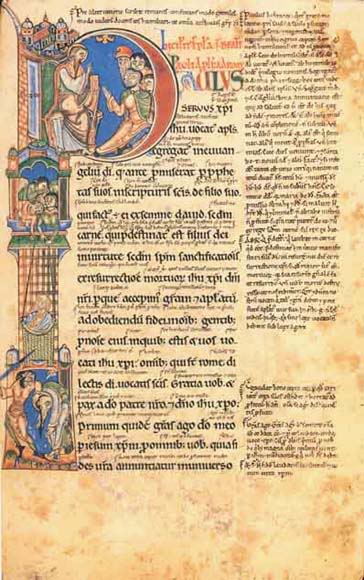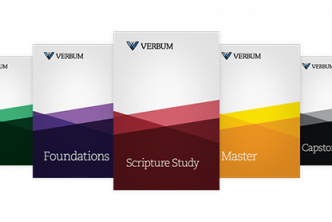I am an ecclesiastical historian by training and a Bible software guy by trade. Which, I think, puts me in the unique position to write about the history of the intersection of technology and Scripture study in a series of posts.
We might start with a description of the Bible we are all used to. It is a stand-alone, printed volume of 73 books (give or take a few), with a more or less fixed text translated from the earliest and best manuscripts. Because of its size, its mass production, and the fact that nearly all of us are literate, we tend to think of the Bible as a self-contained work that is readily available and can be read by anyone and anywhere.
 The Bible was a very different thing in the Middle Ages. That may seem like a bold statement, but let me explain. Medieval Christianity was profoundly sacramental, focusing on an encounter with Christ that was both spiritual and physical. As the theologians of the period frequently remarked, Christ was the Word of God in both His “doing and teaching” (Acts 1:1). For the medieval Christian engagement with the spoken Word of God was not divorced from physical engagement with Christ’s Body, and so the Bible was, above all else, a liturgical book. In the liturgy, the priest read the Scripture, brought the text to life through preaching, and then confected the Eucharist on the altar, introducing Christ’s physical presence. The Word of God in its totality was made present and the encounter with it was total: intellectual, physical, and social. In the liturgy the Christian was understood as united vertically with God and horizontally with his fellow man—all together, the Body of Christ.
The Bible was a very different thing in the Middle Ages. That may seem like a bold statement, but let me explain. Medieval Christianity was profoundly sacramental, focusing on an encounter with Christ that was both spiritual and physical. As the theologians of the period frequently remarked, Christ was the Word of God in both His “doing and teaching” (Acts 1:1). For the medieval Christian engagement with the spoken Word of God was not divorced from physical engagement with Christ’s Body, and so the Bible was, above all else, a liturgical book. In the liturgy, the priest read the Scripture, brought the text to life through preaching, and then confected the Eucharist on the altar, introducing Christ’s physical presence. The Word of God in its totality was made present and the encounter with it was total: intellectual, physical, and social. In the liturgy the Christian was understood as united vertically with God and horizontally with his fellow man—all together, the Body of Christ.
This was the context in which medieval Christians studied the Scripture. Indeed, they often evoked Eucharistic imagery. They “chewed” the Word and “swallowed” it. This was an act of deep reading and meditation on the text that culminated in memorization. But they did not understand memorization as do we. We tend to think of the memory as a hard drive, and memorization as an act of rote drilling that leads to data retention. To the people of the Middle Ages, however, the act of memorization was that of “digesting” the Scripture so that it became a part of who they were. Like how the Eucharist became a part of the body, the Scripture became a part of the mind. Amazing feats of memory are documented, such as being able to recite the Bible backwards. Books, including the Bible itself, were understood more as memory aids than as data storage facilities. The proper place for the Word of God was not on a page but in the Christian’s mind and body. But like the liturgy, the reading of Scripture was a social act across time. And so, it wasn’t just the Scripture that they memorized but the Fathers of the Church, the canons of the councils, the comments of their fellow monks and scholars—a massive tradition. The study of Scripture was an act of mulling the text over, of searching one’s memory and and making new associations, of re-arranging these memorized “packets” of wisdom into original and creative insights. As one did this, the memorized texts became part of one’s personality. Indeed, medieval Christians believed memory was an aspect of moral character.
This approach to the Scripture had technologies that were appropriate to it and that were developed to facilitate it. There were amazingly intricate mental techniques for memorization, whole mental architectures that were built and refined as they were passed on from master to student. Even the physical form of the Bible was a technology. For example, much of the illumination we see in medieval manuscripts functioned as memory “tags,” giving the reader a visual anchor for the memorized text.  But even more impressive than the illuminations were the glosses that surrounded the Scripture text. As monks and scholars read, they would often jot down little reminders in the margins—anonymous sayings, references to, perhaps, St. Augustine or an early council. These were intended primarily as memory aids, so there were often only a few lines or even a couple words—just enough to evoke the memory. These notes are called glosses. Over the centuries, as Bibles were copied and recopied, traded and loaned, a standard gloss grew up around the text. The construction of this gloss was a process of dialogue across centuries as monks and scholars meditated on and digested the Scriptures and engaged with the ancient authorities and each other.
But even more impressive than the illuminations were the glosses that surrounded the Scripture text. As monks and scholars read, they would often jot down little reminders in the margins—anonymous sayings, references to, perhaps, St. Augustine or an early council. These were intended primarily as memory aids, so there were often only a few lines or even a couple words—just enough to evoke the memory. These notes are called glosses. Over the centuries, as Bibles were copied and recopied, traded and loaned, a standard gloss grew up around the text. The construction of this gloss was a process of dialogue across centuries as monks and scholars meditated on and digested the Scriptures and engaged with the ancient authorities and each other.

This glossed Bible was a giant memory aid; and so, its contents were far more than what was actually written. It was, in fact, a technology for accessing a whole library, a certain organization of a vast corpus of knowledge. It was a technology profoundly suited to the medieval understanding of the Word of God as residing primarily in the body of Christians through time, in communion with each other and united in the sacraments. The Scripture was physically, as well as conceptually, surrounded by a tradition that had, like the liturgy, grown up over centuries.
All this changed with the Renaissance. During the late fourteenth and fifteenth centuries a new approach to the Scripture emerged, and with it, new technologies for Scripture study. But that, as they say, is a topic for another post.






Regardless of how we read the bible, the bible is actually a book of the past present, and future. It involves all mankind. We either hearken to the words of God, or follow the evil ways of this world which leads us to everlasting destruction in the future, when armageddon takes place.
[…] were the illuminated and glossed manuscripts, which were at the cutting edge of technology: kind of the Logos of their day: There were amazingly intricate mental techniques for memorization, whole mental architectures that […]
Thank-you for a very interesting and informative piece. I had heard the term ‘glos’ and had some concept of its meaning, but the picture of the main text surrounded by all the supplementary commentary really was worth a thousand words. You phrased certain statements in such a way as to mentally draw the parallel with Logos Bible Software in a very natural way. I look forward to future essays from you.
This is a fantastic post! The third paragraph describing “medieval Christian engagement with the spoken Word of God” is incredibly powerful and succint. I’d enjoy having a link to a high-resolution image of the glossed bible page in this post. Hopefully Dr. Jones will post more on this topic.